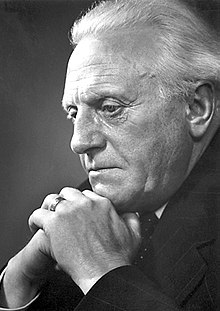Pär Lagerkvist
| Pär Lagerkvist | |
|---|---|
 |
|
| Born |
23 May 1891 Växjö, Sweden |
| Died | 11 July 1974 (aged 83) , Sweden |
| Occupation | poet, playwright, novelist, essayist, short story writer |
| Nationality | Swedish |
| Notable awards |
Nobel Prize in Literature 1951 |
Pär Fabian Lagerkvist (23 May 1891 – 11 July 1974) was a Swedish author who received the Nobel Prize in Literature in 1951.
Lagerkvist wrote poems, plays, novels, stories, and essays of considerable expressive power and influence from his early 20s to his late 70s. One of his central themes was the fundamental question of good and evil, which he examined through such figures as Barabbas, the man who was freed instead of Jesus, and Ahasuerus, the Wandering Jew. As a moralist, he used religious motifs and figures from the Christian tradition without following the doctrines of the church.
Lagerkvist was born in Växjö (Småland). He received a traditional religious education – he would later say, with little exaggeration, that he "had had the good fortune to grow up in a home where the only books known were the Bible and the Book of Hymns". In his teens he broke away from Christian beliefs, but, unlike many other writers and thinkers in his generation, he did not become vehemently critical of religious beliefs as such. Though he was politically a socialist for most of his life, he never indulged in the idea that "religion is the opium of the people". Much of his writing is informed by a lifelong interest in man and his symbols and gods and in the position of Man (both as individual and mankind) in a world where the Divine is no longer present, no longer speaking.
In his early years Lagerkvist supported modernist and aesthetically radical views, as shown by his manifesto Ordkonst och bildkonst (Word Art and Picture Art, 1913) and the play Den Svåra Stunden ("The Difficult Hour").
One of the author's earliest works is Ångest (Anguish, 1916), a violent and disillusioned collection of poems. His anguish was derived from his fear of death, the World War, and personal crisis. He tried to explore how a person can find a meaningful life in a world where a war can kill millions for very little reason. "Anguish, anguish is my heritage / the wound of my throat / the cry of my heart in the world." ("Anguish", 1916.) "Love is nothing. Anguish is everything / the anguish of living." ("Love is nothing", 1916.) This pessimism, however, slowly faded, as testified by his subsequent works, Det eviga leendet (The Eternal Smile, 1920), the autobiographical novel Gäst hos verkligheten (Guest of Reality, 1925) and the prose monologue Det besegrade livet (The defeated Life, 1927), in which the faith in man is predominant. From The Eternal Smile on, his style largely abandoned the expressionist pathos and brusque effects of his early works and there was a strong striving for simplicity, classical precision and clean telling, sometimes appearing close to naivism. The content, however, was never truly naive. A Swedish critic remarked that "Lagerkvist and John the Evangelist are two masters at expressing profound things with a highly restricted choice of words".
...
Wikipedia
